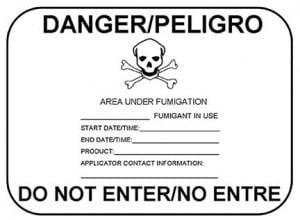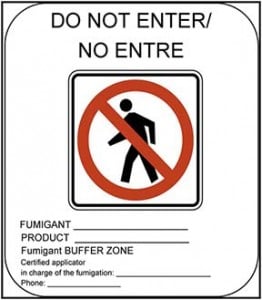Soil Fumigants – including chloropicrin, dazomet, metam sodium/potassium, and methyl bromide – have new safety requirements as of December, 2012. Affected soil fumigants are sold under the brand names Telone, Vapam, K-Pam, and Terr-O-Gas, among others.
This page discusses some of these requirements. More information is available from EPA’s Soil Fumigant Toolbox. Always refer to your label for specifics.
Specific Training for Applicators and Handlers
Applicators must be licensed by NMDA and certified in the appropriate pest control category, and must also complete an EPA approved training program. Applicators must provide each handler involved in the application with specific information and/or training. Handlers include those persons working on equipment that may contain fumigant residues, irrigators, crop advisers or scouts, tractor drivers, shovelers, and tarp cutters/removers. Applicators and other handlers may be required to wear respirators with specific canisters.
Training and safety information are available from US EPA and from dealers where fumigants are purchased.
Planning and Record Keeping
Applicators must prepare a site-specific Fumigant Management Plan (“FMP”) before the application begins and a Post-Application Summary after the fumigation is completed. Templates are available from US EPA and from fumigant manufacturers. FMPs are detailed documents that describe all aspects of the fumigation. Some elements that must be recorded in the FMP are:
- A map showing the application block location and dimensions, buffer zone, property lines, roadways, rights-of-ways, sidewalks, permanent walking paths, bus stops, nearby application blocks, surrounding structures, locations of buffer zone signs, and locations of difficult to evacuate sites
- Buffer zone information (application method and rate, injection depth, application block size, any credits applied and measurements taken to support the credits, buffer zone distance, and description of areas in the buffer zone that are not under the control of the owner of the application block)
- General information such as the applicator's name, phone number, license number; planned fumigation dates; brand name and EPA registration number of fumigant; etc.
- Plans for emergency response, posting, communication, and response information for neighbors if applicable
- Confirmation of training for applicators and handlers; dates of medical qualification, training, and fit testing for all handlers who will wear respirators; confirmation that appropriate respirators and cartridges are immediately available
The Post-Application Summary must be completed within 30 days. It describes any deviations from the FMP, any measures taken to comply with Good Agricultural Practices, and any complaints and/or incidents reported to the applicator. Go to EPA’s page for templates.
Buffer Zones Are Required
A buffer zone, or an area surrounding the treatment site where specific restrictions apply, is mandatory. Buffer zones provide some distance between the application site (usually the edge of a field) and any bystanders, reducing the chance that air concentrations could cause adverse health effects. The size of your buffer zone will depend on the product used, the application rate, the size of the area fumigated, and the method of application, but will be AT LEAST 25 FEET in all directions. The applicator is responsible for keeping all persons out of the treated area and the buffer zone during the fumigation and for at least 48 hours after it ends, except for people in transit, on public or private roadways, via automobile or bicycle. NO PEDESTRIANS are allowed to pass through buffer zones.
If your treatment area is near residential areas, you may have to leave part of your field untreated as part of your buffer zone. Residential areas can only be inside a buffer zone if the occupants agree in writing to voluntarily vacate the property for the full buffer zone time frame. To use any area as part of your buffer zone that is outside the property you are responsible for, you must have written permission from the owner or manager, and they must agree in writing that no one will enter the area.
Applicators who tarp their fields with specific EPA-approved tarps may be able to apply credits that reduce the size of their buffer zones. Refer to your label for specifics.
Fumigated Areas And Buffer Zones Must Be Posted

The area under fumigation must be posted with “Area Under Fumigation” signs. These signs must have the “Skull and Crossbones” symbol, the fumigant used, fumigation start and end dates and times, and contact information for the applicator.

Buffer zones must be posted at usual points of entry and along likely routes of approach. The posted signs must include “DO NOT ENTER/NO ENTRE”, “Fumigant Buffer Zone”, the “do not walk” symbol, the name of the fumigant, and the name and phone number of the applicator.
Appropriate signs should be available where you purchase the fumigant. See this EPA page for more on posting treated areas and buffer zones.
Monitoring/Emergency Preparedness
If residences or other occupied structures are within specified distances of the edge of the buffer zone, the applicator must either monitor the air or provide information to the neighbors. These proximity triggers may extend as far as 300 feet from the edge of the buffer zone in specified circumstances. For example, if there are residences or businesses within 300 feet from the edge of the buffer zone, and if the buffer zone is greater than 300 feet, the applicator must use an air monitor OR provide information to the neighbors.
For more information see US EPA’s Emergency Preparedness Factsheet and refer to your fumigant label.
For More Information
NMDA flyer on New Soil Fumigation Regulations 2013 (pdf)
For fumigant information, templates and online training visit US EPA Soil Fumigant Toolbox
For more information about pesticides visit the National Pesticide Information Center
To purchase respirators and other protective gear visti Honeywell Safety Products
To purchase monitoring equipment and protective gear visti Cardinal Professional Products
Brad Lewis, AES Division Director
ddaes@nmda.nmsu.edu
575-646-3207
